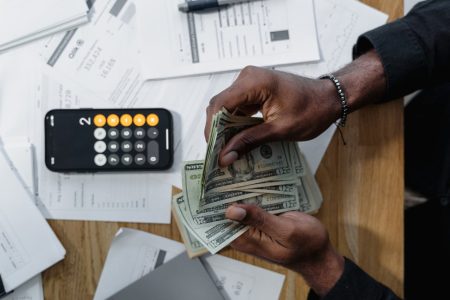Cyber security has become more critical with the exponential growth of online transactions and e-commerce. Hackers across the globe try to invade your privacy in different manners, and one of the most crucial areas they entice is credit card info. If your credit card details are leaked, it won’t be just the finances that will suffer; your identity and privacy may also be breached.
Given this, staying updated about the methods and devices hackers use to steal your money or vital information and the measures to prevent this theft is crucial. This post walks you through 10 credit card data-stealing measures and the ways to combat them.
Table of Contents
Toggle10 Devices/Measures to Steal Credit Card Info
Remember, hackers can get their hands on sensitive data in several ways, including offline and online. The most common ones include the following.
1. Data Breaches
Statista says that in 2019, 1473 data breaching cases occurred in the US, exposing approximately 165 personal data records. The numbers are scary and indicate that data breaches are not limited to high-profile cases – they have become pretty common. Hackers can now seamlessly access the amount of data stored online, which includes credit cards and other crucial information.
The most effective way to combat the chances of data breaching is to use virtual credit cards. They allow you to check out at e-commerce stores without recording your credit card information. However, if you have already become a victim, you should immediately freeze your card and place a fraud alert. Furthermore, you should replace your provider to replace the card. Besides, you should get a new copy of your updated credit report and closely watch for suspicious credit card activities.
2. Skimming
Hackers use this offline method to steal personal information. Credit card skimming usually occurs at a point of sale, which may further lead to identity theft. Using skimming devices, criminals tamper card readers at gas stations, ATMs, departmental stores, and other locations. Skimming involves Radio Frequency Identification technology to intercept chip-based debit or credit cards wirelessly. This technology allows thieves to steal information from cards or smartphones directly.
Usually, they employ Near-field communication-enabled devices for recording encrypted data from the card’s RFID chip. Besides these tech-driven methods, people may steal credit card data using shoulder surfing. This form of skimming depends more on technique than technology. Someone can memorize your credit card information or security code when entering them into an ATM or point of sale.
You can prevent skimming in different ways. For example, you can closely check if an outdoor credit card reader seems tampered. Besides, you can check with your financial institution if they have adequately safeguarded the RFID chip with up-to-date encryption. To prevent shoulder surfing, you can shield keypads with cupping or paperwork.
3. Phishing
Hackers may use phishing to steal your vital information by impersonating a reliable source. There are several schemes for phishing, including sales emails, phone calls, fake websites, etc. For instance, criminals may call you pretending to represent your credit card company and ask you to share some crucial details to verify your credit card activity.
On the other hand, they may simply drop a phishing email as a seller with lucrative discount offers. Such emails may provoke you to share your details to access the offers.
Prevention of phishing is pretty much self-explanatory. You should never share your sensitive personal data, including your credit card details unless you are sure about the provider’s trustworthiness. You should monitor all your transactions sensibly to avoid being a victim of phishing.
4. Malware
Hackers can easily access your data if you mistakenly download malware or spyware. Usually, malware comes with a key logger, which records your keystrokes and browser history and then passes the information to the hackers.
The best way to prevent spyware/malware is to avoid downloads from unverified sources. You should carefully check the applications or programs you install on your devices. For added protection, you can install high-quality antivirus software so that it detects malware before it attacks your device.
5. Wifi Networks
Your credit card information is definitely not safe on unsecured public Wifi networks. Therefore, be careful when logging into free public Wifi networks. You should never share your card details when connected to a public network. If it looks urgent or crucial, use a VPN.
Alternatively, you can stick to trusted and authenticated APNs and service set identifiers. Besides, you always have the alternative of using your cellular data connection.
6. Dumpster Diving
Have you accidentally thrown away your pre-approved credit card in the trash? Or did you put your statements in the dustbin without shredding them? Well, anyone can easily put them out of the trash and use them to steal your money.
You just need to be a little careful. Never throw away any of your documents with sensitive data without shredding them appropriately.
7. Form Jacking
This is a type of cyber attack similar to malware or spyware. Hackers use form-jacking code to inject website forms with spyware. When you fill them up, they steal your credit card details.
Preventing form jacking is not child’s play. However, you must be careful while filling up website forms. If you can’t trust the source, prevent yourself from sharing sensitive information. You can also leverage identity theft protection services to monitor your finances. Moreover, they send your fraud alerts.
8. Account Takeovers
This is a form of identity theft. A fraudster can hack your credit card login information and use your account for various financial activities like taking out fraudulent loans, applying for new credit cards, etc.
To prevent account takeovers, you should carefully monitor the activities of your credit card account. If anything seems unusual, report the activities immediately to your provider.
9. SIM Swapping
Cyber criminals call up mobile operators randomly, pretending to be credit card holders who need duplicate sim cards. They may ask the operator to deactivate your original number. Once their request is granted, they can easily create new IDs, get OTPs, and make online transactions.
Only awareness can prevent this threat. If you receive any warning from your operator about duplicate SIM requests or your number suddenly gets blocked, you should report the issue immediately. This way, your service operator can investigate the issue and take the necessary steps.
10. The Known Culprit
It may sound unusual, but sometimes family members or friends can become the perpetrators of credit card fraud. Someone close to you may have access to your cards and utilize them without letting you know. Alternatively, they can get a credit card in your name. Both instances can severely damage your financial record or credit score.
To prevent these friendly frauds, you should never disclose your card details to anyone. In fact, this is the only way to keep your financial belongings safe.
How to Protect Your Credit Card From Hackers?
You probably have figured out how hackers can steal and misuse your information. Granted, hackers run after the companies that hold your information, and you can hardly stop them from getting there. However, several ways exist to minimize the risk and develop a shield against credit card hacks.
1. Seal Your Credit
This comes in handy when you are caught up in unfortunate data breaches. You can freeze your credit by calling any of the three major credit bureaus. This way, no one can access your report without your permission. This further will prevent creditors from approving applications.
However, you don’t have to be a fraud victim to freeze your credit score. You can simply put a credit freeze on your accounts to prevent breaches. However, this may make getting credit approvals cumbersome for you and prospective lenders.
2. Monitor Phishing
At times, criminals may have your credit card number but may not be aware of your CVV or the card’s expiration date. It would be wise if you kept this information confidential. Confirm with your credit card company if you receive any emails or calls asking for the information.
You can also verify such messages by visiting your provider’s website. Don’t disclose anything without verifying the legitimacy of the sender.
3. Apply for a Replacement Card
If you have been a data breach victim, you should immediately apply for a replacement card. While you are less likely to receive pushback from the already-embarrassed companies, you shouldn’t back down if you do.
Remember, credit card fraud pays a lot. Your card number and information can be sold for over $100 on the black market. Therefore, hackers will always proactively try stealing information, and you should handle it smartly.
4. Play with Passwords
Adhering to standard password guidelines can’t guarantee protection against a breach, as they may only protect your information to a certain extent. Always employ passwords with random numbers. Besides, you should change your passwords periodically.
For added protection, you can employ advanced measures like two-factor authentication. This method sends specific OTP to a trusted device, offering a secondary layer of protection that mixes the physical position of your device before permitting an unknown sign-in.
5. Switch to a Fraud Alert
You can use this as a less drastic alternative to freezing your credit card. All you need to do is, place a fraud alert on your credit profile with the credit bureaus. This can eventually save your credit history from unauthorized access.
Generally, a fraud alert remains valid for a year, and you can renew it once it expires. If you protect your credit history with a fraud alert, lenders will require you to take extra steps to verify your identity when granting new loans in your name.
6. Keep Track of Your Reports
According to United States laws, every credit reporting organization sends you one free credit report yearly. However, if you have ever been a victim of fraud, you can access more frequent reports without paying anything. Alternatively, you can expect more free reports even if you haven’t been a victim of fraud.
You can ask for one credit report every four months from any of the three primary credit reporting agencies. This will help you monitor your report and detect suspicious activities.
7. Perform Online Checks
You should keep on checking your account online to prevent forgery. For instance, if you keep checking your credit card account at least once every day, you will be able to detect suspicious charges more efficiently and raise immediate disputes.
8. Skip Paper Trials
Your credit card statements typically display the full credit card number. Therefore, you should shred them properly before disposing of them. This will help you keep your information confidential, reducing the chances of breaches.
Conclusion
With the advancement of technology and the internet, cybercriminals are becoming smarter. Besides conventional hacking methods, they employ new techniques and devices to steal credit or debit card information. It is high time to become more aware of the abovementioned trends, as most hackers use them to loot your money.
In addition, you may refer to the shared suggestions to prevent data theft and forgery. Access your card securely and enjoy your financial security to the fullest. Good luck!
Frequently Asked Questions
1. How can hackers get your credit card number?
Hackers can obtain your credit card number in several ways. They may include phishing scams,
malware, data breaches, skimming, etc. Therefore, monitoring your credit card transactions regularly is crucial so that you can immediately report any suspicious activity to your credit card issuer.
Additionally, you can take steps to protect your credit card information, such as using strong passwords, avoiding public Wi-Fi when making purchases, and regularly updating your antivirus software.
2. Can anyone use your credit card without CVV?
It is difficult for someone to use your credit card without the CVV. However, it is still possible to do so if they have obtained your credit card number, expiration date, and billing address through a breach or phishing scam.
3. How do you protect your credit after a data breach?
If you have been a victim of a data breach, there are several steps you can take. First, consider placing a freeze on your credit report. Next, monitor your credit card and bank accounts for unauthorized transactions.
In addition, you can enable two-factor authentication on all your online accounts. This adds an extra layer of security by requiring a second form of verification, such as a text message or email.
4. How can you detect card skimmers on ATMs?
You can follow a few simple steps to detect a card skimmer at an ATM. First, check the card slot of the ATM to see if any loose or extra parts are attached to it. Skimmers are often attached to the card slot and can look like an extra piece of plastic.
Next, Look for any small cameras hidden in the ATM. In addition, you can consider wiggling the card slot. If the card feels loose or comes off easily, it could be a sign that a skimmer has been attached to it.
















